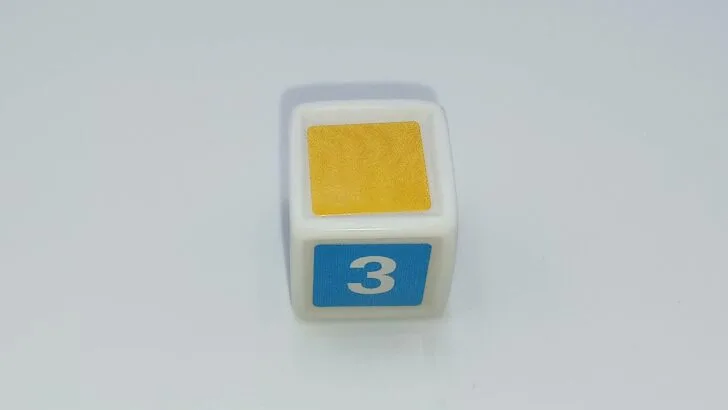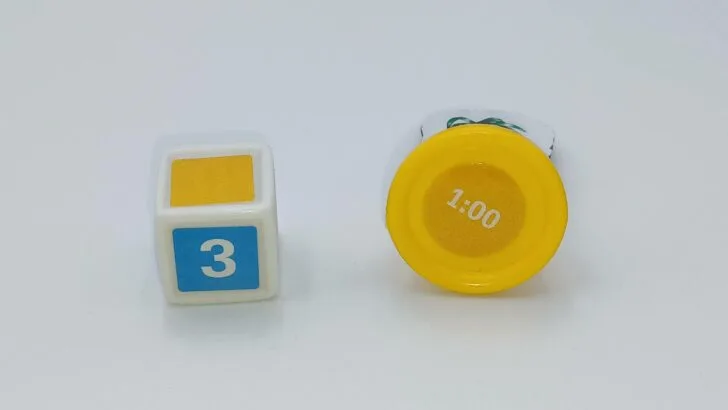Looking for a specific Clue Junior The Case of the Broken Toy rule?: | Setup | Playing the Game | Moving Your Character | Marking Off Information | Solving the Case | FAQ | Components |
Objective of Clue Junior The Case of the Broken Toy
The objective of Clue Junior The Case of the Broken Toy is to be the first player to figure out what toy was broken, who broke it, and when they broke it.
Setup
The first time you play the game you need to complete some additional setup.
- Punch out all of the furniture tokens.
- Randomly place the white and green labels to the bottoms of the white bases. You should place them on the flat side of the bases.
- Stick a yellow label to the bottom of each yellow base.
- Place the square labels on the die.
You need to follow this setup every time you play the game.
- Place all of the yellow bases facedown on the table and mix them up. Without looking at any of the yellow bases, randomly pick one and place it in the middle of the gameboard. The time printed on this base is the time that the toy was broken.
- Randomly select a furniture token to place in each of the yellow bases. Do not look at the bottom of the bases as you put in the furniture tokens. Place each token in its corresponding room on the gameboard.
- Find the white base that has the toy box on it and set it aside. Randomly pick one of the white bases and randomly place it in the middle of the gameboard. This is the toy that was broken.
- Add the toy box base to the rest of the white bases. Mix up all of the bases and randomly place a character pawn on each base. The character that is placed on the base with the toy box was responsible for breaking the toy.
- Place each character on their corresponding start space. You will place all of the characters even if there aren’t six players.
- Each player chooses a character that they will move throughout the game.
- Each player takes a notepad sheet and a pencil.
- The youngest player starts the game.

Rules for Playing Clue Junior The Case of the Broken Toy
To start your turn you will roll the die. What you roll on the die determines what you will do for the rest of your turn.

Should you roll yellow on the die, choose one of the furniture tokens. You can pick any of them. Look at the bottom of the base. The time on the base tells you when the toy wasn’t broken.


When you roll the white side of the die, you will choose one of the character pawns. You can choose any of the characters. You will look at the base of the character to see what toy is pictured.


Finally you can roll a number. When you roll a number you will get to move your character’s pawn.
After you have completed taking the action corresponding to your roll and you have marked off any information you learned, your turn ends. Play passes to the player on your left.
Moving Your Character Pawn
Should you roll a number on the die, you will be able to move your character pawn the corresponding number of spaces. You can move up to the number you rolled. You do not have to use your full roll. When moving you can choose to go in any direction.

When moving you cannot land on a space that has another character already on it. You also can’t end your turn on the space that you began your turn on.
After moving your character you will take an action based on what space you landed on.

If you land on a yellow footprint, you will look at the bottom of the furniture token in your current room.

Should you land on a white footprint, you can look at the bottom of any character pawn.

Finally if you land on a black footprint, you do not get to take any additional action on your turn.
Marking Off the Information You Learned
Depending on what base you got to look at on your turn, you likely learned some information about the case. You should mark on your notepad sheet the information you learned.
If you looked at the bottom of a yellow base, you should cross off the piece of furniture you looked under. This lets you know that you already received that clue and there is no need to look under that piece of furniture again. Next you should cross off the time shown underneath the base. The culprit did not break the toy at that time.

Should you look at a white base, you could have learned one of two pieces of information. If you see a toy, you know that toy is fine (not broken). The character on that base couldn’t have broken the toy. You should cross off both the character and the toy.

If the base had the toy chest on it though, you now know who broke the toy. The character whose base you looked is the culprit. You still need to figure out what toy they broke though.

Solving the Mystery in Clue Junior The Case of the Broken Toy
If you think you know what toy was broken, who was responsible, and when it happened; you can choose to try to solve the mystery. You can choose to solve the mystery at any time on your turn. This includes after you learned information on your turn and crossed off things on your notepad sheet.
When you are ready to solve the mystery you say “[character] broke the [toy] at [time]” filling in each blank with your guess.
You will then look at the two bases in the middle of the gameboard and the base of the character you are accusing.
If the toy and time you guessed are on the bases in the middle of the table, you guessed those two things correctly. For the character base you look at, you are looking for the toy chest.
Winning the Game
Should you guess all three things correctly, you win the game.

Losing the Game
If you are wrong about one or more of the things, you lose the game. You shouldn’t tell the other players what the correct answer was. The rest of the players keep playing the game.

The game continues until someone solves the mystery, or only one player is left in the game. If only one player remains, they win the game.
If you would like to play the game again, you need to mix up the bases and put new characters and furniture on each base.
Clue Junior The Case of the Broken Toy FAQ
If you have any questions about how to play Clue Junior The Case of the Broken Toy, leave a comment below on this post. I will try to answer any questions asked as best and as quickly as possible.

Components
- Gameboard
- 6 character pawns
- 6 furniture tokens
- 7 white bases
- 7 yellow bases
- Detective notepad
- Die
- Instructions
Year: 2018 | Publisher: Hasbro
Genres: Children’s, Deduction
Ages: 5+ | Number of Players: 2-6 | Length of Game: 15-20 minutes
Difficulty: Light | Strategy: Light | Luck: Moderate
For more board and card game rules/how to plays, check out our complete alphabetical list of card and board game rules posts.

